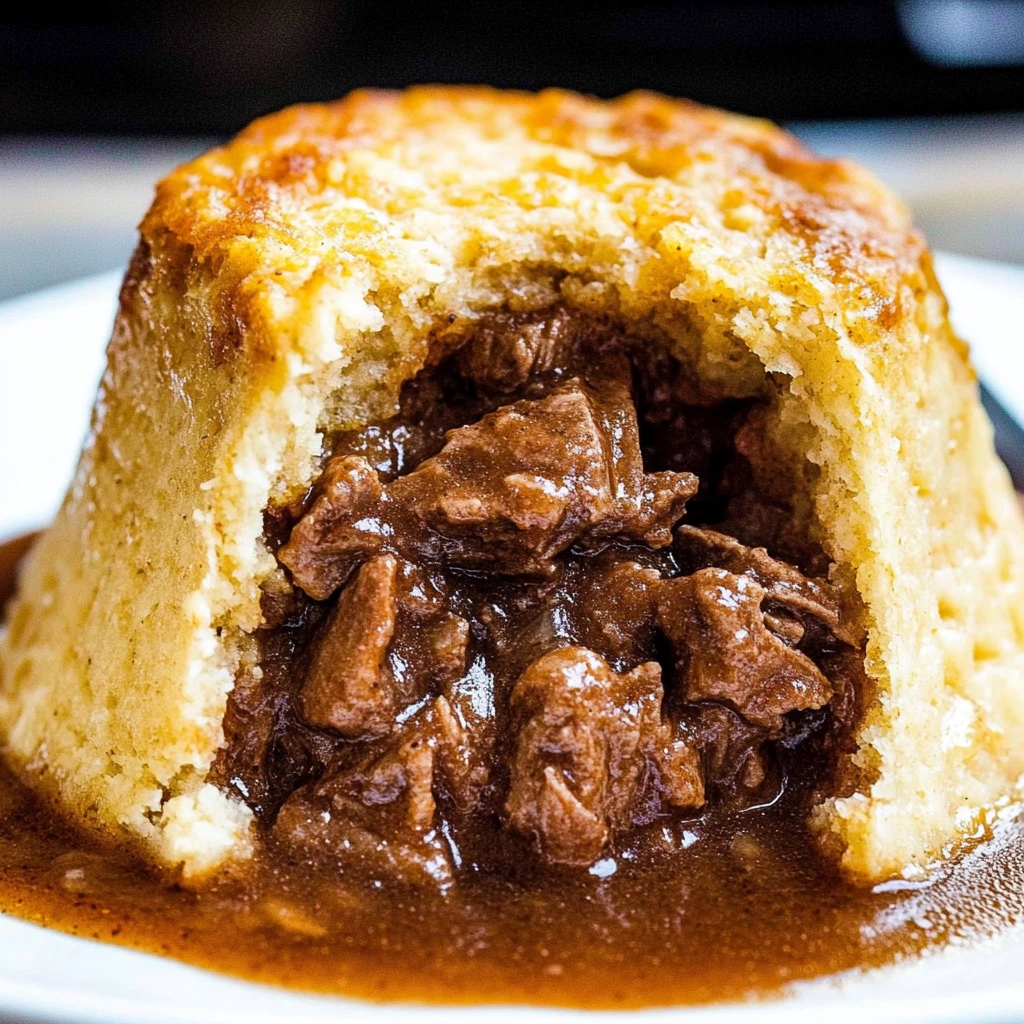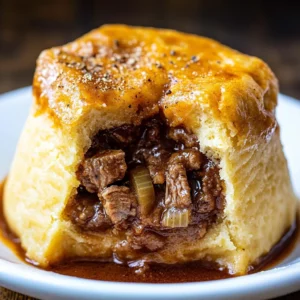Hearty British Comfort – Let’s Talk About Steak & Onion Suet Pudding
If there’s one dish that screams “comfort food” to me, it’s this rich, hearty Steak & Onion Suet Pudding. Just the name alone takes me back to slow Sunday afternoons at my nan’s house, where the kitchen smelled of stewed beef, buttery mash, and sweet, slow-cooked onions. This dish is traditional, no doubt, but it’s also seriously satisfying—perfect for a cozy weekend meal that fills both your belly and your soul.
Now, if you’ve never made a suet pudding before, don’t let the old-fashioned vibes scare you off. It might sound like something straight out of a British pub menu (because it is), but it’s honestly super achievable at home—and so worth it. We’re talking tender chunks of beef, soft onions, and a rich gravy, all wrapped in a fluffy, slightly crisp suet crust. Then it’s gently steamed until the whole thing becomes this amazing, self-contained pot of savory deliciousness.
Why You’ll Love This Recipe
-
It’s rich, hearty, and incredibly flavorful.
-
The suet pastry is surprisingly simple to make from scratch.
-
It’s the perfect make-ahead meal—great for family dinners or meal prepping.
-
It makes you feel like a comfort food rockstar. Trust me.
Let’s Get Started – The Filling First
We’re going to begin by building layers of flavor, starting with the beef. For this recipe, I like to use braising steak (also known as stewing beef), which becomes beautifully tender after it cooks slowly in the gravy.
Ingredients for the Filling:
-
500g braising steak, diced into 2cm pieces
-
2 large onions, thinly sliced
-
100g mushrooms (optional, but so good)
-
2 tbsp plain flour
-
300ml beef stock
-
1 tbsp Worcestershire sauce
-
1 tsp dried thyme
-
Salt & black pepper, to taste
Step 1: Brown That Beef
This step is where we start building flavor. Toss your diced steak in the flour, then sear it in a hot pan until it’s beautifully browned on all sides. Don’t overcrowd the pan—do it in batches if needed. This part makes such a difference in the final taste, giving that rich, caramelized meatiness that you want in a dish like this. Set the beef aside once it’s browned.
Step 2: Soften the Onions (and Mushrooms, If You’re Using Them)
Using the same pan (because flavor!), toss in your sliced onions—and mushrooms if you’re feeling it. Cook them down for about 5 minutes, just until they’re soft and golden. This step makes your kitchen smell amazing, by the way.
Step 3: Simmer Everything into a Gravy
Return your beef to the pan with the onions. Pour in the beef stock, Worcestershire sauce, dried thyme, and season with salt and pepper. Give it all a good stir and let it come to a gentle simmer. Cook it for about 5 minutes more, then take it off the heat and let it cool just slightly while we move on to the pastry.
Next Up: That Suet Pastry Crust
If you’ve never worked with suet before, don’t worry—it’s actually really easy. Suet gives you that traditional soft and slightly crumbly crust that holds up so well to the rich filling. It’s one of those ingredients that makes a dish feel authentic, and the texture it brings is something butter just can’t quite match.
Ingredients for the Suet Pastry:
-
225g self-raising flour
-
100g beef suet
-
½ tsp salt
-
120ml cold water (you may not need it all)
Step 4: Make the Pastry
In a large bowl, rub the suet into the flour and salt until the mixture resembles coarse breadcrumbs. Then, add the cold water gradually—just a little at a time—until you get a soft, pliable dough. You don’t want it sticky, just enough so it comes together nicely.
Step 5: Line Your Pudding Basin
Roll out about two-thirds of your pastry on a floured surface. Grease a 1.2L pudding basin, then gently line it with the rolled-out pastry, making sure it comes all the way up the sides and leaves a little overhang at the top. This is your edible container for all that savory goodness.
And that’s where we’ll leave off for now! In Part 2, we’ll finish assembling the pudding, talk steaming tips, and share a few tricks to make sure everything turns out just right.
Have you ever made a suet pudding before, or is this your first time giving it a go?
Assembling and Steaming the Perfect Suet Pudding
Alright—now that we’ve prepped our filling and made that gorgeous suet pastry, it’s time for the fun part: assembling and steaming your Steak & Onion Suet Pudding! If this is your first time working with a pudding basin and steaming, don’t stress. I’ll walk you through each step, and by the end, you’ll feel like you’ve just conquered a British cooking rite of passage.
So far, we’ve made a rich beef filling and lined our pudding basin with suet pastry. Now let’s bring it all together.
Step 6: Fill the Basin with That Glorious Beef Mixture
By now your filling should be slightly cooled, which makes it easier to work with and helps avoid a soggy pastry bottom (no one wants that). Spoon the beef and onion mixture into your pastry-lined basin. Make sure to get a nice balance of meat, onion, and gravy. The filling should be thick and saucy—not soupy.
Tip: If your gravy feels too thin, just let it simmer for a few more minutes on the stove before adding it to the pastry. A thicker filling holds up better and makes for a cleaner cut when you serve it.
Step 7: Seal It Up with the Pastry Lid
Roll out the remaining third of your pastry to create a lid that fits over the top. Before sealing, dampen the edges of the base pastry with a bit of water so it sticks properly. Then press the lid on top and crimp the edges together to seal it all in. Trim any excess pastry—neat edges are easier to seal and steam evenly.
Step 8: Prepare for Steaming
This is where the traditional method really shines. You’ll need to cover your pudding tightly to trap the steam in and protect that lovely pastry crust.
Here’s how:
-
Cut a piece of greaseproof paper and a piece of foil, both large enough to cover the top of the basin.
-
Fold a pleat into both layers (about 2 inches wide) to give the pudding room to expand as it cooks.
-
Place the paper on first, then the foil, and tie both tightly around the basin with kitchen string.
-
If your basin has a lid, you can still use the foil layer as extra protection.
Tip: Loop some extra string across the top to make a handle—it makes lifting the basin in and out of the pot much easier.
Step 9: Steam for 3 Hours
Set the basin into a large pot or deep saucepan. Pour in boiling water so it comes halfway up the sides of the basin. Cover with a lid and let it steam gently for 3 hours. Keep the heat on a low simmer and don’t forget to check the water level occasionally—top it up with boiling water as needed.
Don’t rush this part—the slow, moist heat is what makes the beef melt-in-your-mouth tender and gives the pastry that perfectly fluffy texture.
Serving Time – It’s Worth the Wait
Once your pudding has steamed to perfection, carefully lift it out and let it sit for a couple of minutes before turning it out onto a plate. I always hold my breath at this part—but every single time, that golden crust and rich aroma are totally worth the anticipation.
Slice it up and serve with buttery mashed potatoes, steamed greens, or even a classic mushy pea situation if you’re going full British pub vibes. It’s warm, comforting, and somehow even better the next day—if you have any leftovers, that is!
Tips & Variations
I’ve made this recipe a dozen different ways over the years, and here are a few little tricks and variations to keep in your back pocket:
-
Make-Ahead Tip: You can prepare the beef filling a day ahead. In fact, I think it tastes even better after sitting overnight in the fridge. The flavors deepen, and it makes assembly quicker the next day.
-
No Suet? No Problem: If you can’t find suet, you can substitute it with cold grated butter. The texture won’t be quite as soft and fluffy, but it still works.
-
Add a Twist: A dash of red wine in the gravy, or a spoonful of wholegrain mustard stirred into the beef mix, can really elevate the flavor.
-
Veggie Version: Want to try a meat-free version? Swap the steak for chunks of mushrooms and root vegetables like carrots and parsnips. Use veggie stock instead of beef stock for a hearty, vegetarian twist.
That’s it for the main recipe steps! In Part 3, we’ll cover some frequently asked questions and wrap things up with a little encouragement to make this traditional British dish your own.
Have you thought about serving it with a rich onion gravy or maybe a horseradish cream on the side?
FAQs and Final Thoughts on This Classic Steak & Onion Suet Pudding
By now, your kitchen probably smells like a dream—savory beef, sweet caramelized onions, and that unmistakable cozy aroma of steamed pastry. Honestly, this recipe feels like a warm hug in food form. Whether you’re making it for a hearty Sunday roast or just looking to try something uniquely British, this Steak & Onion Suet Pudding is bound to win hearts (and appetites).
Before we wrap up, let’s answer a few of the most common questions readers have about this classic recipe.
👩🍳 Frequently Asked Questions
1. Can I freeze Steak & Onion Suet Pudding?
Yes! You can freeze the fully cooked and cooled pudding. Wrap it tightly in foil and plastic wrap, then freeze for up to 3 months. Reheat by re-steaming for about an hour, or microwave individual portions until hot.
2. Can I make it without a pudding basin?
You can use a heatproof bowl or deep ceramic dish with similar volume (around 1.2L). Just make sure it’s oven-safe and steam-proof.
3. What’s a good substitute for suet?
If you can’t find beef suet, you can use cold grated butter or vegetable shortening. The texture might be slightly different (a bit more crumbly), but it still tastes delicious.
4. How do I know it’s done steaming?
The pudding should feel firm to the touch, and when you invert it, the pastry should hold its shape. If the dough still feels raw or sticky, give it another 30 minutes of steaming.
5. Can I make this vegetarian?
Definitely! Swap out the beef for mushrooms, carrots, parsnips, or lentils. Use vegetable suet (or butter) and veg stock to keep it meat-free while still packed with flavor.
6. What should I serve with it?
I love it with buttery mashed potatoes, steamed greens, or braised cabbage. Don’t forget a splash of gravy on the side—so good!
7. Can I make it ahead of time?
Yes, and honestly, it’s even better the next day! You can prep the filling a day in advance, or steam the whole pudding and reheat when needed.
Final Thoughts – Time to Dig In!
This Steak & Onion Suet Pudding is everything a comfort meal should be: rich, warming, and made with love. Whether you grew up eating traditional British fare or this is your first foray into the world of suet crusts and steaming basins, this recipe is a keeper.
It’s a little old-school, sure—but sometimes the best meals are the ones that have stood the test of time. I hope you give it a try and make it your own. Add your own twist, or keep it classic—it’s guaranteed to satisfy either way.
And if you do make it, I’d love to hear how it turned out! Leave a comment, share your photos, or let me know if you gave it your own spin. This is the kind of dish that brings people together—and that’s what comfort food is all about. ❤️
Print
Traditional Steak and Onion Suet Pudding – A Classic British Comfort Food Recipe
- Total Time: 3 hours 30 minutes
Description
This traditional Steak and Onion Suet Pudding is filled with tender beef, sweet onions, and savory gravy, wrapped in soft suet pastry. The perfect comfort food for a cozy weekend meal!
Ingredients
For the Filling:
-
500g braising steak, diced into 2cm chunks
-
2 large onions, thinly sliced
-
100g mushrooms, sliced (optional)
-
2 tbsp plain flour
-
300ml beef stock
-
1 tbsp Worcestershire sauce
-
1 tsp dried thyme
-
Salt & black pepper, to taste
For the Suet Pastry:
-
225g self-raising flour
-
100g beef suet
-
½ tsp salt
-
Approx. 120ml cold water
Instructions
Prepare the Filling:
-
Toss the steak in flour and brown in batches over high heat. Set aside.
-
In the same pan, cook onions (and mushrooms) for about 5 minutes until golden.
-
Return beef to the pan, add stock, Worcestershire sauce, thyme, salt, and pepper. Simmer for 5 minutes, then let cool slightly.
2. Make the Suet Pastry:
-
In a bowl, mix flour, suet, and salt. Gradually add cold water until a soft dough forms.
3. Assemble the Pudding:
-
Roll out two-thirds of the dough and line a greased 1.2L pudding basin.
-
Spoon in the cooled filling.
-
Roll out the remaining dough as a lid, dampen the edges, seal, and trim.
-
Cover with a pleated sheet of greased paper and foil, tied securely.
4. Steam the Pudding:
-
Place the basin in a large pan with boiling water halfway up the sides.
-
Cover and steam for 3 hours, checking the water level occasionally.
-
Rest for a few minutes before unmolding and serving.
Notes
-
Filling can be made a day ahead and chilled for deeper flavor.
-
Suet can be swapped for cold grated butter or vegetable shortening.
-
Steam leftovers to reheat, or microwave individual slices for convenience.
-
Don’t forget to pleat your foil/paper so the pudding has room to rise.
- Prep Time: 30 minutes
- Cook Time: 3 hours












